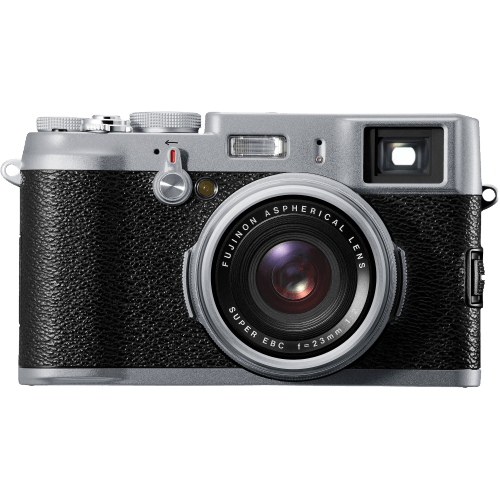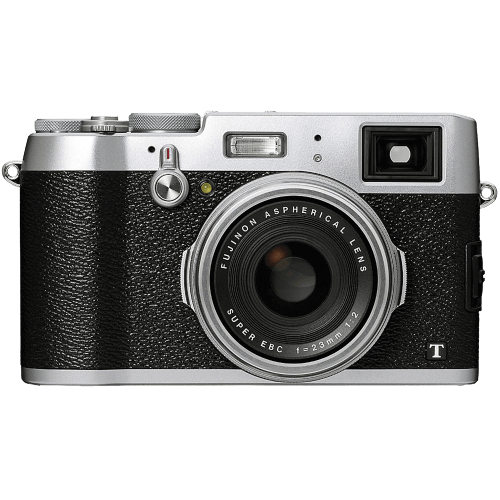Fujifilm FinePix X100 vs X100T Comparison
Fujifilm FinePix X100

Fujifilm X100T

The Fujifilm X100T takes the lead with a score of 53/100, while the Fujifilm FinePix X100 trails with 42/100. Both cameras share similarities, such as being compact and having similar dimensions and weight. The X100T is slightly lighter at 440g, compared to the X100’s 445g.
The X100T outshines the X100 with its mirrorless technology, making it more advanced and efficient. Additionally, the X100T is a newer model, released in 2015, whereas the X100 was released in 2010. However, the X100 has a lower launch price of $999, compared to the X100T’s $1300 price tag.
Taking these factors into account, the Fujifilm X100T is the superior camera due to its updated technology and higher score, while the Fujifilm FinePix X100 may appeal to budget-conscious buyers.
Fujifilm FinePix X100 vs X100T Overview and Optics
The Fujifilm X100T wins in the optics comparison with a score of 54/100, while the Fujifilm FinePix X100 scores 48/100. Both cameras share several common specifications, such as the APS-C sensor size, CMOS sensor type, EXR processor, and the absence of image stabilization. Additionally, neither camera has a lens mount, as both utilize fixed lens mounts.
The X100T outperforms the FinePix X100 in certain aspects. It has a higher megapixel count of 16 compared to the X100’s 12.3, which allows for capturing more detailed images. The X100T also boasts a faster shooting speed of 6, compared to the X100’s 5, providing the ability to capture fast-moving subjects more efficiently. Moreover, the X100T features an upgraded EXR Processor II, contributing to faster image processing and better overall performance.
On the other hand, the FinePix X100 does not offer any significant advantages over the X100T in terms of optics. Both cameras lack image stabilization and lens mount flexibility, which limits their versatility in various shooting situations.
In terms of optics, the Fujifilm X100T is the superior camera, as it provides better image quality and performance due to its higher megapixel count, faster shooting speed, and upgraded processor. The FinePix X100 falls short in these aspects, and does not offer any notable advantages to compensate for its shortcomings. Therefore, for those prioritizing optics, the Fujifilm X100T is the better choice.
Fujifilm FinePix X100 vs X100T Video Performance
The Fujifilm X100T outperforms the Fujifilm FinePix X100 in video capabilities, scoring 70/100 compared to the FinePix X100’s 34/100. This significant difference in scores highlights the superiority of the X100T in this category.
Both cameras share some common specifications, such as the ability to record video. However, the X100T offers Full HD video resolution with maximum dimensions of 1920 x 1080, while the FinePix X100 only provides Standard HD resolution with dimensions of 1280 x 720. This means that the X100T captures more detailed and higher quality video footage than the FinePix X100.
Additionally, the X100T has a maximum video frame rate of 60fps, which is more than double the FinePix X100’s 24fps. This higher frame rate enables smoother and more fluid video recording on the X100T, providing a noticeable advantage over its counterpart. Furthermore, the X100T includes built-in time-lapse functionality, a feature absent in the FinePix X100. This allows for creative and captivating time-lapse videos without the need for additional equipment or software.
Despite the lower video score, the FinePix X100 may still be suitable for users who do not prioritize video capabilities and are content with standard HD resolution and a lower frame rate. However, it is clear that the X100T offers a more comprehensive and advanced video experience.
Considering the significant difference in video scores and the superior specifications of the Fujifilm X100T, it is evident that this camera is the better choice for those seeking higher quality video performance. The FinePix X100 may suffice for casual video recording, but the X100T clearly stands out as the more capable option.
Fujifilm FinePix X100 vs X100T Features and Benefits
The Fujifilm X100T emerges as the winner with a feature score of 58/100, compared to the Fujifilm FinePix X100’s score of 34/100. Both cameras share some common specifications, such as the absence of a touchscreen and GPS functionality. However, the Fujifilm X100T outperforms the FinePix X100 in several aspects.
The X100T has a larger screen size of 3 inches, compared to the FinePix X100’s 2.8-inch screen. Additionally, the X100T’s screen resolution is significantly higher at 2,360,000 dots, providing a clearer and more detailed image preview. The FinePix X100’s screen resolution is only 460,000 dots. The X100T also features a flip screen, allowing for more flexible shooting angles and better self-portraits.
Connectivity is another area where the X100T excels over the FinePix X100. The X100T has both Wi-Fi and Bluetooth capabilities, making it easier to transfer files and control the camera remotely. The FinePix X100 lacks these connectivity options.
While the FinePix X100 falls short in these areas, it does not possess any noticeable advantages over the X100T. The lower feature score of the FinePix X100 reflects its limited capabilities compared to the X100T.
Taking all these factors into account, the Fujifilm X100T is the superior camera in terms of features. The larger screen size, higher screen resolution, flip screen, and better connectivity options make the X100T a more versatile and user-friendly option than the FinePix X100.
Fujifilm FinePix X100 vs X100T Storage and Battery
The Fujifilm X100T outperforms the FinePix X100 in storage and battery with a score of 21/100 compared to the FinePix X100’s 16/100. Both cameras have one memory card slot and accept SD, SDHC, and SDXC memory cards. The X100T, however, is compatible with the faster UHS-I cards, offering a significant advantage in data transfer speeds.
The X100T also boasts a longer battery life, with 330 shots per charge, compared to the FinePix X100’s 300 shots. Both cameras use the NP-95 battery type. While the FinePix X100 does not offer any advantages in storage and battery, it is worth noting that neither camera has USB charging capabilities.
Based on these factors, the Fujifilm X100T is the superior choice in terms of storage and battery performance. Its compatibility with faster memory cards and extended battery life provide a better user experience and convenience for photographers.
Fujifilm FinePix X100 vs X100T – Our Verdict
Are you still undecided about which camera is right for you? Have a look at these popular comparisons that feature the Fujifilm FinePix X100 or the Fujifilm X100T:

